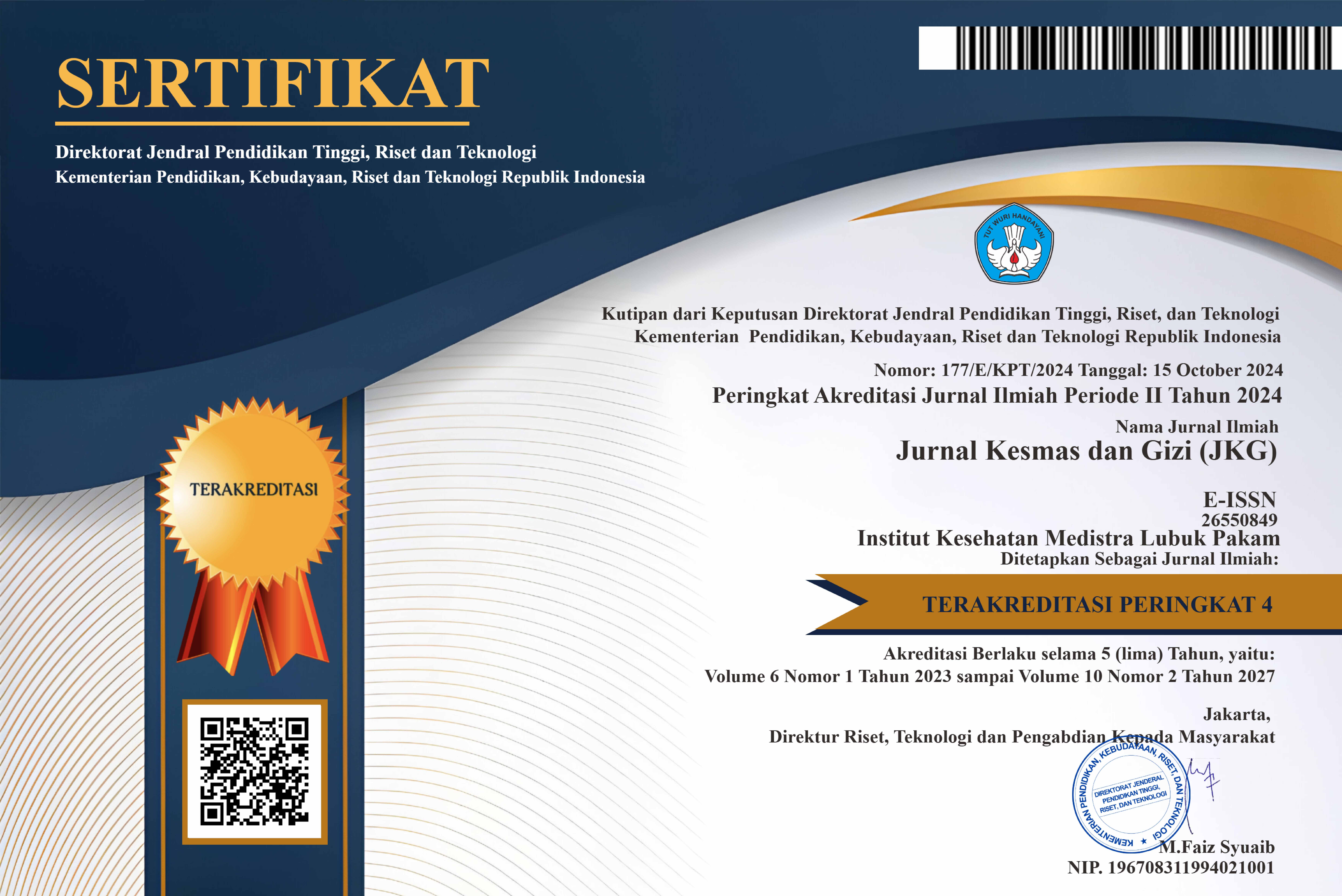Factors Related To The Level Of Knowledge On Clean Living Behaviorand Healthy (Phbs) In Banda Aceh Primary Students
DOI:
https://doi.org/10.35451/jkg.v6i2.2094Keywords:
Kata kunci: PHBS, Siswa/Siswi, Sekolah DasarAbstract
Clean and healthy living behavior is the essence for the sustainability of the program launched by the government as an indicator of sustainable health improvement achievements. The realization of PHBS in school settings needs to be pursued, to increase self-awareness of the results of the target, namely students and school residents and supported by the existence of facilities and infrastructure. This study aims to determine the factors related to the level of knowledge of clean and healthy living behavior (PHBS) in students of SD N 58 Alue Naga Banda Aceh. The type of research used is quantitative with a cross-sectional research design, namely research that studies the correlation between exposure or independent risk factors (level of knowledge, sex, attitude, personal hygiene, and incidence of diarrhea) with dependent effects or effects (PHBS). The sampling technique used was total sampling and obtained 82 students of grades V, and VI.. Data analysis is univariate and bivariate. Based on the analysis using coputerization with the chi-squre test, it was found that there was a significant relationship between the level of knowledge (p-value 0.027), gender (p-value 0.017), attitude (p-value 0.040), personal hygiene (p-value 0.027) and history of diarrhea (p-value 0.018) on clean and healthy living behavior (PHBS) in students of SDN 58 Alue Naga Banda Aceh. The conclusion of the results of this study is that there is a significant relationship between the level of knowledge, gender, attitude, personal hygiene, and the incidence of diarrhea on PHBS students of SD N 58 Alue Naga Banda Aceh.
Downloads
References
Sehat (PHBS)’, Jurnal Kesehatan Masyarakat Khatulistiwa, 4, p. 3.
Fadhila, N.A. and Rangkuti, A.F. (2021) ‘Faktor-Faktor Yang Berhubungan Dengan Phbs Pada Mahasiswa Fakultas Kesehatan Masyarakat Universitas Ahmad Dahlan’, Jurnal Kesehatan dan Pengelolaan Lingkungan, 2(2), pp. 123–129. Available at: https://doi.org/10.12928/jkpl.v2i2.6339.
Gabur, M.G., Yudiernawati, A. and Dewi, N. (2017) ‘Hubungan Perilaku Hidup bersih dan Sehat (PHBS) terhadap Personal Hygiene Anak Usia Sekolah Di SDN Tlogomas 2 Malang’, Journal Nursing News, 2(1), pp. 533–542.
Kementrian Kesehatan RI (2018) ‘Laporan Riskesdas 2018 Nasional’, Kementerian Kesehatan Republik Indonesia, pp. 146–379.
Lawrence Green (2020) Teori Lawrence Green dan Aplikasinya dalam Perubahan Perilaku Kesehatan, scribd. Available at: https://www.scribd.com/document/516418568/Teori-Green-Theory-Lawrence-Green.
Nugroho, D.S. (2019) ‘Hubungan Antara Tingkat Pengetahuan Dengan Perilaku Hidup Bersih Dan Sehat Siswa Di Madrasah Ibtidaiyah Muhammadiyah Gonilan Kartasura Sukoharjo’, 151, pp. 10–17.
Nurhaeda and Uki, E. (2020) ‘Hubungan Tingkat Pengetahuan Dan Sikap Siswa Dengan Praktek PHBS Di Sekolah Dasar 2 Inpres Lambunu Kecamatan Bolano Lambunu Kabupaten Parigi Moutong The Relationship Between Students’ Knowledge Levels And Attitudes With PHBS Practice At Elementary School’, Media Publikasi Penelitian Kebidanan, 3(1), pp. 8–14. Available at: https://institutgrahaananda.ac.id/jurnal/index.php/mppk/article/view/31/23.
Nurhidayah, I., Asifah, L., & Rosidin, U. (2021). Pengetahuan, Sikap dan Perilaku Hidup Bersih dan Sehat pada Siswa Sekolah Dasar. The Indonesian Journal of Health Science, 13(1), 61–71. https://doi.org/10.32528/ijhs.v13i1.4864
Prihatini, G.S. et al. (2018) ‘Faktor-Faktor Yang Mempengaruhi Tingkat Perilaku Hidup Bersih dan Sehat Pada Tatanan Rumah Tangga Di Wilayah Kerja Puskesmas Ponde x’, Saintika Medika, 14(1), pp. 7–14.
Sarah, A., Fauzan, A. and Ernadi, E. (2020) ‘Faktor - Faktor Yang Berhubungan Dengan Perilaku Hidup Bersih Dan Sehat (Phbs) Pada Siswa Di Sekolah Mi Al-Hidayah Batulicin-Tanah Bumbu Tahun 2020’, Jurnal Kesehatan Masyarakat, pp. 1–8. Available at: http://eprints.uniska-bjm.ac.id/2584/1/Artikel Ayuni Sarah.pdf.
Sari, N.I., Widjanarko, B. and Kusumawati, A. (2016) ‘Faktor-faktor yang berhubungan dengan perilaku hidup bersih dan sehat sebagai upaya untuk pencegahan penyakit diare pada siswa di sd n karangtowo kecamatan Karangtengah Kabupaten Demak’, Jurnal Kesehatan Masyarakat, 4(3), pp. 2356–3346. Available at http://ejournal-s1.undip.ac.id/index.php/jkm.
Suryani, L. (2018) ‘Faktor-Faktor Yang Mempengaruhi Perilaku Hidup Bersih Dan Sehat (Phbs) Siswa/I Sekolah Dasar Negeri 37 Kecamatan Tampan Kota Pekanbaru’, Jurnal Keperawatan Abdurrab, 1(2), pp. 17–28. Available at:http://jurnal.univrab.ac.id/index.php/keperawatan/article/view/255.
Ulin Ni’mah, A. (2019) ‘Hubungan Perilaku Hidup Bersih dan Sehat (PHBS) serta Kebiasaan Jajan dengan Kejadian Diare Pada Siswa di SD Negeri 1 Kemiri, Boyolali’, Universitas Muhammadiyah Surakarta [Preprint].
Downloads
Published
Issue
Section
License
Copyright (c) 2024 Riski Aulia zulkifli, Meutia Zahara, Riza Septiani

This work is licensed under a Creative Commons Attribution 4.0 International License.
Copyright in each article is the property of the Author.


























